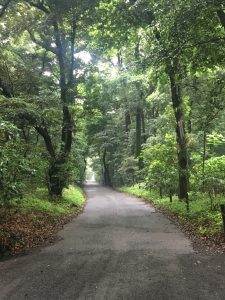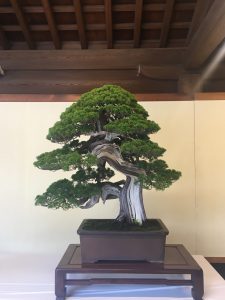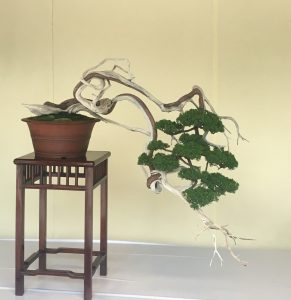Another intellectually engaging day has passed! It was very long (spent over 12 hours away from our Airbnb), but the experience was unforgettable and without a doubt worth it.
Japanese people are fluid with religion (is there a Japanese sense of religion?). Selinger 先生の友だちは Notoさんです。She was so nice and informative! She presented on Shinto and introduced us to important aspects of Meiji Shrine. We learned that it is normalized for Japanese people (in general) to follow multiple religions. Noto-san gave an example that it’s not unusual for someone here to go to a Shinto Shrine as a newborn, have a wedding at a Christian church, celebrate Christmas, visit family graves at “Obon” Buddhism festival, and hold their funeral at a Buddhist temple. I found it interesting that in one of the statistic tables she showed us Shinto was listed as a religious organization. The reading we had to do for today made several attempts to define Shinto, but I don’t think it’s too important to try to define what exactly Shinto is because it doesn’t seem productive to waffle around (lol because I am a person who waffles around too much). Perhaps this is because I am neither a scholar in religion nor have any interest in being one… I want to just let it exist and take it in respectfully (is this too passive though?). She talked about kami (神) and emphasized its importance as god-like but not the Western idea of a god. People can be 神 (e.g. Selinger 先生, Christmas 先生, and Aridome 先生). There was a quote that explained 神 as “possessing the quality of excellence and virtue.” In discussion later we talked about the important points of who is defining 神 and what their motivation is. Not really sure about the answer to the first question, but perhaps their motivation is to separate it from foreign ideas and make something uniquely Japanese. Anyway, I wanted to also point out that Noto-san taught us the importance of purifying yourself before visiting 神. Again, the notion of purity in Japan returns! We got to experience an amazing Shinto ceremony (lol we got our prayer read! unfortunately I only heard the アジアけんきゅう line because of my under-developed 日本語 skills). There was an offering in the form of song and dance, which was great to watch. I was self-conscious as to what times we had to bow and what times we could watch, so I hope following along what the person beside me was doing went okay. At the end, we each got a little gift and a sip of さけ. I was not expecting that… ahhh お酒が好きじゃないですよ (not just さけ specifically)… although, I will say it was warm and not a horribly unpleasant experience… anyway, I asked what the point of it was and Noto-san said it basically purifies the body. The さけ we drank was an offering to the 神 and then given to us to drink.
Can a human-constructed forest left “untouched” be classified as natural? According to the Kanji, no. The forest surrounding Meiji Shrine is referred to as 鎮守の杜 (chinju no mori), which is different from the kanji used for similar sacred forests (鎮守の森, also chinju no mori). This is because 鎮守の杜 is “man-made,” as the area it resides in was once a wasteland then through the planting of trees by humans, made to be a forest. The path in which humans take in the forest is highly regulated and protected so that it can be, for the most part, untouched by humans. Yay for the reoccurrence of the Japanese importance of purity! Tanaka-san, a highly knowledge and approachable man who helps maintain 鎮守の杜, answered our questions while showing us around (shoutout to Julian since he asked great questions). We entered quite a few prohibited-to-the-public areas, which made us feel super special and grateful to Tanaka-san (and Noto-san for arranging this!). Wow, the trees were just so impressive and surreal. I honestly thought the greenery should be photographed as an Apple desktop wallpaper. きれいな杜。I can’t wait to see Anna-san pictures!
I’m trying to improve my Japanese, so I will try to jot down new things I’ve learnt. Here are some words I have learned so far: しけ (humid), ながでずがり (the flowing style that the buildings in Meiji had), しつも (question), いこ (casual form of “let’s go”), and 食べほうだい (all you can eat). I’ve definitely become more interested in and motivated to learn the Japanese language since arriving in Japan. I can see myself taking classes/studying after Bowdoin, and I know this won’t be my last time here.
This isn’t totally related to the theme of this post, but we went to a Hawaiian-themed Korean barbecue place for dinner. I have to say that it was a weird experience because I did not feel like I was in Japan; at times I actually forgot that I should be practicing my Japanese. During this trip, I have been very aware that I’m in Japan, so attempting Japanese seemed like what I should be doing, but at this restaurant speaking English seemed more like what I should be doing. (I wish I could comment about cultural appropriation, but I don’t feel like I can express my thoughts intelligently or effectively. And despite the two semesters of anthropology courses I’ve taken, I just don’t think I have enough background to really define cultural appropriation or speak on behalf of Hawaiian culture. I will just say that the restaurant being Hawaiian-themed was not the most comfortable experience).




